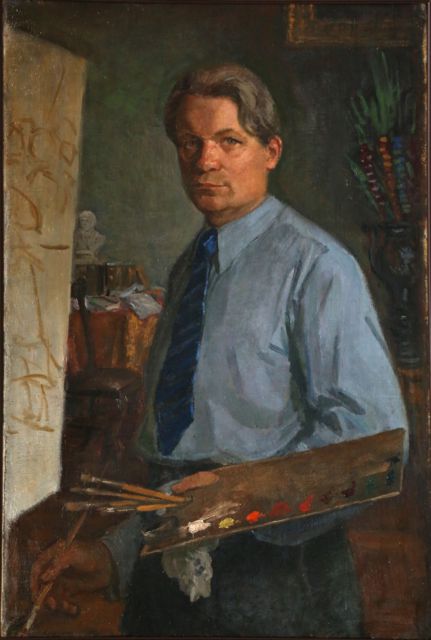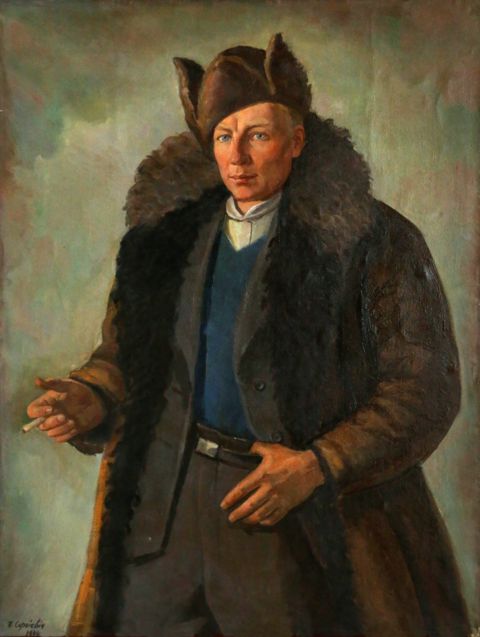To the National Day of Unity
Piotr Sierhijevich was called as ‘Belarusian Matejko’ and ‘heaven-born artist’ by his contemporaries from Western Belarus. Piotr Sierhijevich as well as Jazep Drazdovich is from the bunch of the first Belarusian national artists in Western Belarus. His art is extremely different. Sometimes it is hard to believe that paintings are made by the same author.
The artist’s symbolic paintings of 1920–the 1940s and portraits of representatives of the Belarusian intelligentsia in the 20th century are the most fascinating works among his artistic legacy. He painted 140 paintings and 160 graphic portraits: well-known figures of the Belarusian intelligentsia – Zośka Vieras, Liavon Lutskievich, Jazep Drazdovich and Maksim Tank, and many countrymen from Braslaŭ – peasants, teachers, priests, doctors, young and old people. There are 27 portraits by the master in the museum. In total, the museum has 28 works by Piotr Sierhijevich.
Piotr Sierhijevich was born into a poor peasant family in Stavrovo Village, Disnensky District, Boginskaya Volost and Vilna Province in the Russian Empire (now Braslaŭ District and Viciebsk Region) on July 10, 1900. He was brought up with a brother and a sister. His father died when he was 7. So, the boy’s childhood was troubled: ‘Living in poverty, we had to look for a piece of bread some place’, – the artist wrote in his ‘Autobiography’. It was published in magazine ‘Mastatstva’ in 1993. He soon became interested in art. The mother supported him, and she shipped Piotr off to the school of Józef Montwiłł in Vilna. The teacher admired his drawings. But, the family could not afford to pay for the school anymore, and the boy transferred to the Platter Factory School near Stavrovo.
‘It is time to focus on one thing’, – the mother told her son, who tried to earn doing different work to help the family. He went to earn money to Saint Petersburg in 1917. He took a class in engineering, and he worked at the securities factory. At the same time, the future artist visited the art studio of Aleksandr Andreyev.
He made his artistic career in Vilna, which became part of Poland from 1921 till 1940, according to the Peace of Riga. ‘There is Belarusian spirit in Vilna’, – Piotr Sierhijevich often said. He studied as a non-resident student (1920–1928) at the Fine Arts Faculty of the Stephen Báthory University. He became a member of the Belarusian Students’ Community from the 1920s. The artist started to sign his works in Belarusian. So, he remade his name Piotr into ‘Piotra or Piatro’. The dean of the Fine Arts Faculty was famous Ferdynand Ruszczyc who accepted the future artist as an irregular student. Ruszczyc bought his drawing of the Basilian walls. Piotr Sierhijevich had his hospitable workshop in Antokol, a suburb of Vilna. He loved the realistic portrait as well as his teacher Benedict Kubitsky, a student of Ilya Repin.
Piotr Sierhijevich was interested in graphics and sanguine (‘red chalk’) that is a method of drawings by Italian Renaissance artists. The artist liked sanguine due to his other teacher Ludomir Sleńdziński. The portraits of the 1930s present physiological similarity in male portraits (‘Engineer Dubeykovsky’, 1940), and light idealization in the portraits of women (‘Portrait of a Girl’, 1938). They demonstrate the author’s culture of drawing and ability to stylize his nature study in the spirit of the Renaissance.
However, he wanted to show facts of life and to be closer to village people. ‘We need to be with the people, and we need to look for our place in the world’, – Sierhijevich wrote in magazine ‘Kalossie’ in 1936. Peasants and his countrymen became the main characters of a number of portraits and drawings.
The ‘peasant core’ as a special constructive basis in Sierhijevich’s work, which critics wrote about, is seen in a combination of romanticism, realism and naive expressionism. This can also be seen in his portraits.
He was lucky to spend two weeks in Rome, Venice and Florence in 1938. He saw the works by the great artists of the Renaissance. Piotr Sierhijevich spent his last money buying a lot of reproductions and books in Italy. After the artist had come back, he showed them to Maksim Tank. This short trip and study of frescos by the Quattrocento artists helped Piotr Sierhijevich to make a lot of monumental works for Belarusian churches. He painted images of saints as local peasants who were the poorest worshippers in the parish. ‘Master Sierhijevich is the bright national artist... I am looking at some new portraits of his Braslaŭ countrymen on the wall. The portrayed people belong to the proper class position. There is a peasant’s stamina, self-confidence and belief in a better future in their eyes ’, – Maksim Tank wrote in his diary.
Piotr Sierhijevich, an obsessive expert and amateur of Belarusianity, began to cooperate with the Belarusian Museum named after its founder Ivan Luckievič in the early 1930s. He went to Navahrudak on the expedition to collect exhibits for the museum in 1932. He led the work of sculptor Rafał Jachimowicz in 1935. The sculptor was commissioned to make the bust of Ivan Luckievič from an old photo. By the way, Piotr Sierhijevich made the famous graphic portrait of Luckievič in 1934. The portrait became classics.
‘Piotr Sierhijevich is a completely Belarusian painter’, – critic Jan Malecki noted in Belarusian magazine ‘Shliakh moladzi’. He approved the artist’s series of portraits ‘Belarusian Folk Types’.
The Minsk Soviet authorities became interested in Sierhijevich’s work after the unification of Soviet Belarus with Western Belarus in 1939. The event was met with enthusiasm by the artist. The reproductions of his works appeared in newspapers. The Union of Artists of the BSSR planned to hold the solo exhibition of Piotr Sierhijevich in Minsk in 1941. ‘There are all conditions for Mr. Sierhijevich’s creativity with the advent of Soviet power’, – wrote I. Rubinshtein, the head of the Union of Artists of the BSSR.
But, the war and the fascist occupation crossed out these plans. Piotr Sierhijevich returned home (Braslaŭ Region), where he continued to work on portraits of peasants (‘for bread and fat’). Then he moved to Vilna, where he worked as a ‘specialist in Belarusian art’ and a conservator at the Belarusian Museum named after Ivan Luckievič from 1944.
The master’s career continued in Soviet Lithuania after the end of the war. He taught at the Painting Faculty of the Vilna Academy of Arts for five years. He sent his works to republican exhibitions in Minsk. Piotr Sierhijevich easily fit into the new style of socialist realism for him, although, his work for some time retained the old ideals of Western Belarusian romanticism. It was easy for him, because the basis of his work was clearly realistic. ‘It is important to paint what excites a person, and do not go through the motions <...> I cut and repaint some of my old canvases, but mostly I will work on the portrait’, – he wrote to Minsk artist Mikalaj Duchyts in 1967.
The master’s personal skills – interest in any person and rare internal empathy – made him an excellent portrait painter. The artist’s optimism and emotions contributed to the fact that each of his portraits became an example of a humanistic attitude to a person. He wanted to emphasize the best qualities of his models.
‘Modesty, simplicity and sincerity are the main features of his creative method’, – wrote his colleague, artist Vladas Drėma.
Soon he was recognized as a portrait painter in his homeland. His characteristic portrait ‘Partisan Fedya’ (1946) came to the Art Museum after the war. This is the artist’s cousin, who was a partisan during the war. He was a model for Piotr Sierhijevich to paint the portrait of Kastuś Kalinoŭski in the 1950s. The original photo was found after a while.
The exhibition of Piotr Sierhijevich was held at the State Art Museum of the BSSR in 1962. The monograph dedicated to the 70th anniversary of the artist was published by Arsien Lis in 1970. He and the artist had been friends for more than ten years. The artist’s big exhibition was held at the Palace of Arts in Minsk in 1978. The artistic intelligentsia bought many paintings at the exhibition. His ‘Self Portrait’ (1948) with brushes and a palette, and three graphic works were purchased by the State Art Museum. The old master was perceived as a legend, being a kind of pilgrim. Belarusian artists traveled to Vilna to listen to his memories of Drazdovich and Ruszczyc. ‘He is different from us by some real intellectuality’, – writer Uladzimir Karatkievich thought.
The master’s career continued in Soviet Lithuania after the end of the war. He taught at the Painting Faculty of the Vilna Academy of Arts for five years. He sent his works to republican exhibitions in Minsk. Piotr Sierhijevich easily fit into the new style of socialist realism for him, although, his work for some time retained the old ideals of Western Belarusian romanticism. It was easy for him, because the basis of his work was clearly realistic. ‘It is important to paint what excites a person, and do not go through the motions <...> I cut and repaint some of my old canvases, but mostly I will work on the portrait’, – he wrote to Minsk artist Mikalaj Duchyts in 1967.
The master’s personal skills – interest in any person and rare internal empathy – made him an excellent portrait painter. The artist’s optimism and emotions contributed to the fact that each of his portraits became an example of a humanistic attitude to a person. He wanted to emphasize the best qualities of his models.
‘Modesty, simplicity and sincerity are the main features of his creative method’, – wrote his colleague, artist Vladas Drėma.
Soon he was recognized as a portrait painter in his homeland. His characteristic portrait ‘Partisan Fedya’ (1946) came to the Art Museum after the war. This is the artist’s cousin, who was a partisan during the war. He was a model for Piotr Sierhijevich to paint the portrait of Kastuś Kalinoŭski in the 1950s. The original photo was found after a while.
The exhibition of Piotr Sierhijevich was held at the State Art Museum of the BSSR in 1962. The monograph dedicated to the 70th anniversary of the artist was published by Arsien Lis in 1970. He and the artist had been friends for more than ten years. The artist’s big exhibition was held at the Palace of Arts in Minsk in 1978. The artistic intelligentsia bought many paintings at the exhibition. His ‘Self Portrait’ (1948) with brushes and a palette, and three graphic works were purchased by the State Art Museum. The old master was perceived as a legend, being a kind of pilgrim. Belarusian artists traveled to Vilna to listen to his memories of Drazdovich and Ruszczyc. ‘He is different from us by some real intellectuality’, – writer Uladzimir Karatkievich thought.
Until the last days, the artist was energetic, like a young man. He had a lot of creative plans. He worked on portraits almost until the early 1980s. He became seriously ill then. Piotr Sierhijevich wanted that the Belarusian Museum would be in his workshop. He even kept the sign from the former museum named after Luckievič. Piotr Sierhijevich died in 1984. He left an enormous legacy: 603 works made by him over 84 years of his life (he kept a detailed list of paintings in chronological order from his youth). Most of them are portraits.
Piotr Sierhijevich is the national Belarusian artist in terms of the content and form of his work, in terms of the subject and type of the main characters.


